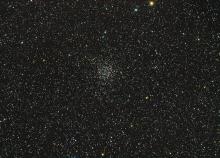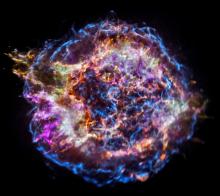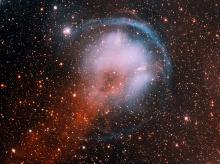Listen to today's episode of StarDate on the web the same day it airs in high-quality streaming audio without any extra ads or announcements. Choose a $8 one-month pass, or listen every day for a year for just $30.
You are here
Beta Cassiopeia
The Sun spins on its axis at a leisurely rate — it takes about four weeks to complete a single turn. Some other stars, though, are like electric blenders on high. They can make a full turn in days or even hours — even though they might be a lot bigger than the Sun.
An example is Beta Cassiopeia. It’s about half way up the northwestern sky at nightfall. It forms the lower left point of the prominent letter “M” outlined by five bright stars of the constellation Cassiopeia.
Beta Cass is about twice the Sun’s mass, and about 30 times its brightness. And a spot at its equator spins dozens of times faster than the Sun — a full turn in just 1.1 days. In fact, Beta Cass is rotating just about as fast as it possibly could — just a few percent faster and it would fly apart.
That high-speed rotation has some interesting effects. For one thing, it pushes gas at the star’s equator outward. As a result, Beta Cass is about 25 percent fatter through the equator than through the poles. And since the poles are closer to the star’s core, where it produces energy, they’re a couple of thousand degrees hotter than the equator. The higher temperature makes the poles brighter than the equator as well.
Beta Cass is less than a quarter of the age of the Sun, but it’s already at the end of its “normal” lifetime. It’s getting bigger and cooler. That process may slow the star’s rotation a little — turning down the speed on a stellar blender.
Script by Damond Benningfield





